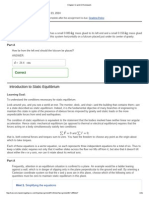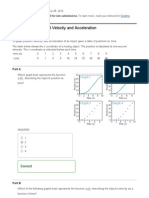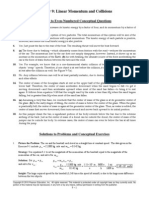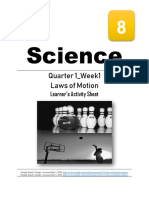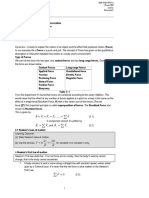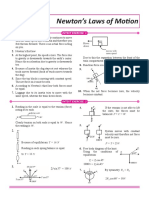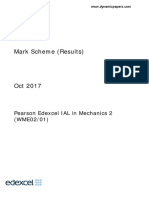Chapter 04 Homework
Uploaded by
Fatboy91Chapter 04 Homework
Uploaded by
Fatboy913/3/2014
Chapter 4 Homework
Chapter 4 Homework
Due: 10:00pm on Friday, February 21, 2014
You will receive no credit for items you complete after the assignment is due. Grading Policy
Exercise 4.1
Two forces have the same magnitude F .
Part A
What is the angle between the two vectors if their sum has a magnitude of 2F ?
ANSWER:
= 0
Correct
Part B
What is the angle between the two vectors if their sum has a magnitude of 2F ?
ANSWER:
= 90
Correct
Part C
What is the angle between the two vectors if their sum has a magnitude of zero?
ANSWER:
= 180
Correct
Two Hanging Masses
Two blocks with masses M 1 and M 2 hang one under the other. For this problem, take the positive direction to be
upward, and use g for the magnitude of the acceleration due to gravity.
Typesetting math: 80%
http://session.masteringphysics.com/myct/assignmentPrintView?assignmentID=2776490
1/32
3/3/2014
Chapter 4 Homework
Case 1: Blocks at rest
For Parts A and B assume the blocks are at rest.
Part A
Find T2 , the tension in the lower rope.
Express your answer in terms of some or all of the variables M 1 ,
M2
, and g.
Hint 1. Free-body diagram
Isolate the lower block (mass
M2
) by considering just the forces that act on it. Use Newton's 2nd law while
noting that the acceleration of this block is zero.
Hint 2. Sum of forces
Write down the sum of the y components of all the forces acting on the lower block.
Express your answer in terms of some or all of the variables M 1 ,
M2
T2
and g.
ANSWER:
F2y = M 2 a2 = 0
T2 M 2 g
ANSWER:
T2
M2 g
Correct
http://session.masteringphysics.com/myct/assignmentPrintView?assignmentID=2776490
2/32
3/3/2014
Chapter 4 Homework
Part B
Find T1 , the tension in the upper rope.
Express your answer in terms of some or all of the variables M 1 ,
M2
, and g.
Hint 1. Sum of forces
Write down the sum of the y components of all the forces acting on the upper block.
Express your answer in terms of some or all of the variables M 1 ,
M2
T1
T2
, and g.
ANSWER:
F1y = 0
T1 T2 M 1 g
ANSWER:
T1
(M 1 + M 2 )g
Correct
Case 2: Accelerating blocks
For Parts C and D the blocks are now accelerating upward (due to the tension in the strings) with acceleration of
magnitude a.
Part C
Find T2 , the tension in the lower rope.
Express your answer in terms of some or all of the variables M 1 ,
M2
, a, and g.
Hint 1. Sum of forces
Apply Newton's 2nd law,
Fy = M 2 a
, to the lower block. Write the sum of the y components of the
forces.
Express your answer in terms of some or all of the variables M 1 ,
M2
T2
and g.
ANSWER:
F2y = M 2 a
T2 M 2 g
ANSWER:
http://session.masteringphysics.com/myct/assignmentPrintView?assignmentID=2776490
3/32
3/3/2014
Chapter 4 Homework
T2
M 2 (a + g)
Correct
Good! Now notice that acceleration acts in the tension equation the same way that gravity does. If we look at a
limiting case in which the block of mass M 2 is in free fall, accelerating downward with a = g, then the
tension goes to zero.
Part D
Find T1 , the tension in the upper rope.
Express your answer in terms of some or all of the variables M 1 ,
M2
, a, and g.
Hint 1. Sum of forces
Consider the block of mass
M1
as an isolated system and apply Newton's 2nd law,
Fy = M 1 a
, with
the value of T2 found in the previous part.
ANSWER:
T1
(M 1 + M 2 )(a + g)
Correct
The force exerted by a rope is a result of the rope's tension and points along the rope.
Exercise 4.3
Due to a jaw injury, a patient must wear a strap (see the figure) that produces a net upward force of 5.00N on his chin.
The tension is the same throughout the strap.
http://session.masteringphysics.com/myct/assignmentPrintView?assignmentID=2776490
4/32
3/3/2014
Chapter 4 Homework
Part A
To what tension must the strap be adjusted to provide the necessary upward force?
ANSWER:
F
= 3.15
Correct
Newton's 1st Law
Learning Goal:
To understand Newton's 1st law.
Newton's Principia states this first law of motion:
An object subject to no net force maintains its state of motion, either at rest or at constant speed in a right line.
This law may be stated as follows: If the sum of all forces acting on an object is zero, then the acceleration of that
object is zero. Mathematically this is just a special case of the 2nd law of motion, F = m a when F = 0 , prompting
scholars to advance the following reasons (among others) for Newton's spelling it out separately:
1. This expression only holds in an inertial coordinate system--one that is not accelerating--and this law
really says you have to use this type of coordinate system (i.e., Newton's laws won't work inside an
accelerating rocket ship.)
2. This was a direct challenge to the Impetus theory of motion, described as follows:
A mover, while moving a body, impresses on it a certain impetus, a certain power capable of moving this
body in the direction in which the mover set it going, whether upwards, downwards, sideways or in a circle.
By the same amount that the mover moves the same body swiftly, by that amount is the impetus that is
impressed on it powerful. It is by this impetus that the stone is moved after the thrower ceases to move it;
but because of the resistance of the air and the gravity of the stone, which inclines it to move in a
direction opposite to that towards which the impetus tends to move it, this impetus is continually
weak ened. Therefore the movement of the stone will become continually slower, and at length, the
impetus is so diminished or destroyed that the gravity of the stone prevails over it and moves the stone
down towards its natural place.
A. C. Crombie, Medieval and Early Modern Science</>
This theory is sometimes called the Animistic theory of motion since it envisions a "life force" being
associated with motion.
Newton's 1st law is often very difficult to grasp because it contradicts various common-sense ideas of motion that they
have acquired from experience in everyday life. For example, unaccounted for forces like friction might cause a ball
rolling on the playground to eventually stop, even though no obvious forces seem to be acting.
When studying Newtonian mechanics, it is best to remember this as two laws:
1. If the net force (i.e., sum of all forces) acting on an object is zero, the object will keep moving with
constant velocity (which may be zero).
2. If an object is moving with constant velocity (not speed), that is, with zero acceleration, then the net force
acting on that object must be zero.
Complete the following sentences to see if you can apply these ideas.
Part A
http://session.masteringphysics.com/myct/assignmentPrintView?assignmentID=2776490
5/32
3/3/2014
Chapter 4 Homework
If a car is moving to the left with constant velocity, one can conclude that
ANSWER:
there must be no forces applied to the car.
the net force applied to the car is directed to the left.
the net force applied to the car is zero.
there is exactly one force applied to the car.
Correct
Part B
An object cannot remain at rest unless
ANSWER:
there are no forces at all acting on it.
the net force acting on it is zero.
the net force acting on it is constant.
there is only one force acting on it.
Correct
Understanding Newton's Laws
Part A
An object cannot remain at rest unless which of the following holds?
Hint 1. How to approach the problem
This problem describes a situation of static equilibrium (i.e., a body that remains at rest). Hence, it is
appropriate to apply Newton's 1st law.
Hint 2. Newton's 1st law: a body at rest
According to Newton's 1st law, a body at rest remains at rest if the net force acting on it is zero.
ANSWER:
http://session.masteringphysics.com/myct/assignmentPrintView?assignmentID=2776490
6/32
3/3/2014
Chapter 4 Homework
The net force acting on it is zero.
The net force acting on it is constant and nonzero.
There are no forces at all acting on it.
There is only one force acting on it.
Correct
If there is a net force acting on a body, regardless of whether it is a constant force, the body accelerates. If the
body is at rest and the net force acting on it is zero, then it will remain at rest. The net force could be zero
either because there are no forces acting on the body at all or because several forces are acting on the body
but they all cancel out.
Part B
If a block is moving to the left at a constant velocity, what can one conclude?
Hint 1. How to approach the problem
This problem describes a situation of dynamic equilibrium (i.e., a body that moves at a constant velocity).
Hence, it is appropriate to apply Newton's 1st law.
Hint 2. Newton's 1st law: a body in motion
According to Newton's 1st law, a body initially in motion continues to move with constant velocity if the net
force acting on it is zero.
ANSWER:
There is exactly one force applied to the block.
The net force applied to the block is directed to the left.
The net force applied to the block is zero.
There must be no forces at all applied to the block.
Correct
If there is a net force acting on a body, regardless of whether the body is already moving, the body
accelerates. If a body is moving with constant velocity, then it is not accelerating and the net force acting on it
is zero. The net force could be zero either because there are no forces acting on the body at all or because
several forces are acting on the body but they all cancel out.
Part C
A block of mass
2 kg
is acted upon by two forces:
3 N
(directed to the left) and 4
(directed to the right). What
can you say about the block's motion?
http://session.masteringphysics.com/myct/assignmentPrintView?assignmentID=2776490
7/32
3/3/2014
Chapter 4 Homework
Hint 1. How to approach the problem
This problem describes a situation of dynamic motion (i.e., a body that is acted on by a net force). Hence, it
is appropriate to apply Newton's 2nd law, which allows you to relate the net force acting on a body to the
acceleration of the body.
Hint 2. Newton's 2nd law
Newton's 2nd law states that a body accelerates if a net force acts on it. The net force is proportional to the
acceleration of the body and the constant of proportionality is equal to the mass of the body. In other words,
,
F = ma
where F is the net force acting on the body, and m and a are the mass and the acceleration of the body,
respectively.
Hint 3. Relating acceleration to velocity
Acceleration is defined as the change in velocity per unit time. Keep in mind that both acceleration and
velocity are vector quantities.
ANSWER:
It must be moving to the left.
It must be moving to the right.
It must be at rest.
It could be moving to the left, moving to the right, or be instantaneously at rest.
Correct
The acceleration of an object tells you nothing about its velocity--the direction and speed at which it is moving.
In this case, the net force on (and therefore the acceleration of) the block is to the right, but the block could be
moving left, right, or in any other direction.
Part D
A massive block is being pulled along a horizontal frictionless surface by a constant horizontal force. The block
must be __________.
Hint 1. How to approach the problem
This problem describes a situation of dynamic motion (i.e., a body that is acted on by a net force). Hence, it
is appropriate to apply Newton's 2nd law, which allows you to relate the net force acting on a body to the
acceleration of the body.
Hint 2. Newton's 2nd law
Newton's 2nd law states that a body accelerates if a net force acts on it. The net force is proportional to the
acceleration of the body and the constant of proportionality is equal to the mass of the body. In other words,
F = ma
http://session.masteringphysics.com/myct/assignmentPrintView?assignmentID=2776490
8/32
3/3/2014
Chapter 4 Homework
F = ma
where F is the net force acting on the body, and m and a are the mass and the acceleration of the body,
respectively.
ANSWER:
continuously changing direction
moving at constant velocity
moving with a constant nonzero acceleration
moving with continuously increasing acceleration
Correct
Since there is a net force acting, the body does not move at a constant velocity, but it accelerates instead.
However, the force acting on the body is constant. Hence, according to Newton's 2nd law of motion, the
acceleration of the body is also constant.
Part E
Two forces, of magnitude 4 N and 10 N , are applied to an object. The relative direction of the forces is unknown.
The net force acting on the object __________.
Check all that apply.
Hint 1. How to approach the problem
By definition, the net force is the vector sum of all forces acting on the object. To find the magnitude of the
net force you need to add the components of the two forces acting. Try adding the two forces graphically (by
connecting the head of one force to the tail of the other). The directions of the two forces are arbitrary, but by
trying different possibilities you should be able to determine the maximum and minimum net forces that
could act on the object.
Hint 2. Find the net force when the two forces act on the object in opposite directions
Find the magnitude of the net force if both the forces acting on the object are horizontal and the 10-N force is
directed to the right, while the 4-N force is directed to the left.
Express your answer in newtons.
Hint 1. Vector addition
The magnitude of the vector sum of two parallel forces is the sum of the magnitudes of the forces.
The magnitude of the vector sum of two antiparallel forces is the absolute value of the difference in
magnitudes of the forces.
ANSWER:
http://session.masteringphysics.com/myct/assignmentPrintView?assignmentID=2776490
9/32
3/3/2014
Chapter 4 Homework
6.0
Correct
Is there any other orientation of the two forces that would lead to a net force with a smaller magnitude
than what you just calculated?
Hint 3. Find the direction of the net force when the two forces act in opposite directions
If both the forces acting on the object are horizontal and the 10-N force is directed to the right, while the 4-N
force is directed to the left, the net force is horizontal and directed __________.
ANSWER:
in the same direction as the 10-N force
in the opposite direction to the 10-N force
Correct
ANSWER:
cannot have a magnitude equal to 5
cannot have a magnitude equal to 10 N
cannot have the same direction as the force with magnitude 10
must have a magnitude greater than 10
Correct
Exercise 4.10
A dockworker applies a constant horizontal force of 80.0N to a block of ice on a smooth horizontal floor. The frictional
force is negligible. The block starts from rest and moves a distance 10.5m in a time 5.30s .
Part A
What is the mass of the block of ice?
ANSWER:
m
= 107
kg
Correct
http://session.masteringphysics.com/myct/assignmentPrintView?assignmentID=2776490
10/32
3/3/2014
Chapter 4 Homework
Part B
If the worker stops pushing at the end of 5.30s , how far does the block move in the next 4.80s ?
ANSWER:
x
= 19.0
Correct
Exercise 4.14
A 3.45-kg cat moves in a straight line (the x-axis). the figure
shows a graph of the x-component of this cat's velocity as a
function of time.
Part A
When does the maximum net force on his cat occur?
ANSWER:
in the interval
t = 0
to t
in the interval
t = 2.00
to t
= 6.00 s
in the interval
t = 6.00
to t
= 10.00 s
= 2.00 s
.
.
.
Correct
Part B
Find the magnitude of the maximum net force on this cat.
ANSWER:
http://session.masteringphysics.com/myct/assignmentPrintView?assignmentID=2776490
11/32
3/3/2014
Chapter 4 Homework
F
= 13.8
Correct
Part C
When is the net force on the cat equal to zero?
ANSWER:
in the interval
t = 0
to t
in the interval
t = 2.00
to t
= 6.00 s
in the interval
t = 6.00
to t
= 10.00 s
= 2.00 s
.
.
.
Correct
Part D
What is the magnitude of the net force at time 8.5 s?
ANSWER:
F
= 3.45
Correct
Exercise 4.19
At the surface of Jupiter's moon Io, the acceleration due to gravity is 1.81m/s2 . A watermelon has a weight of 57.0N at
the surface of the earth. In this problem, use 9.81m/s2 for the acceleration due to gravity on earth.
Part A
What is its mass on the earth's surface?
ANSWER:
m
= 5.81
kg
Correct
Part B
http://session.masteringphysics.com/myct/assignmentPrintView?assignmentID=2776490
12/32
3/3/2014
Chapter 4 Homework
What is its mass on the surface of Io?
ANSWER:
m
= 5.81
kg
Correct
Part C
What is its weight on the surface of Io?
ANSWER:
w
= 10.5
Correct
Tension in a Massless Rope
Learning Goal:
To understand the concept of tension and the relationship between tension and force.
This problem introduces the concept of tension. The example is a rope, oriented vertically, that is being pulled from both
ends. Let Fu and \texttip{F_{\rm d}}{F_d} (with u for up and d
for down) represent the magnitude of the forces acting on the
top and bottom of the rope, respectively. Assume that the
rope is massless, so that its weight is negligible compared
with the tension. (This is not a ridiculous approximation-modern rope materials such as Kevlar can carry tensions
thousands of times greater than the weight of tens of meters
of such rope.)
Consider the three sections of rope labeled a, b, and c in the
figure.
At point 1, a downward force of magnitude
\texttip{F_{\rm ad}}{F_ad} acts on section a.
At point 1, an upward force of magnitude
\texttip{F_{\rm bu}}{F_bu} acts on section b.
At point 1, the tension in the rope is
\texttip{T_{\rm 1}}{T_1}.
At point 2, a downward force of magnitude \texttip{F_{\rm bd}}{F_bd} acts on section b.
At point 2, an upward force of magnitude \texttip{F_{\rm cu}}{F_cu} acts on section c.
At point 2, the tension in the rope is \texttip{T_{\rm 2}}{T_2}.
Assume, too, that the rope is at equilibrium.
http://session.masteringphysics.com/myct/assignmentPrintView?assignmentID=2776490
13/32
3/3/2014
Chapter 4 Homework
Part A
What is the magnitude \texttip{F_{\rm ad}}{F_ad} of the downward force on section a?
Express your answer in terms of the tension \texttip{T_{\rm 1}}{T_1}.
ANSWER:
\texttip{F_{\rm ad}}{F_ad} = T_{1}
Correct
Part B
What is the magnitude \texttip{F_{\rm bu}}{F_bu} of the upward force on section b?
Express your answer in terms of the tension \texttip{T_{\rm 1}}{T_1}.
ANSWER:
\texttip{F_{\rm bu}}{F_bu} = T_{1}
Correct
Part C
The magnitude of the upward force on c, \texttip{F_{\rm cu}}{F_cu}, and the magnitude of the downward force on b,
\texttip{F_{\rm bd}}{F_bd}, are equal because of which of Newton's laws?
ANSWER:
1st
2nd
3rd
Correct
Part D
The magnitude of the force \texttip{F_{\rm bu}}{F_bu} is ____ \texttip{F_{\rm bd}}{F_bd}.
ANSWER:
http://session.masteringphysics.com/myct/assignmentPrintView?assignmentID=2776490
14/32
3/3/2014
Chapter 4 Homework
less than
greater than
equal to
Correct
It is important to realize that \texttip{F_{\rm bu}}{F_bu} and \texttip{F_{\rm bd}}{F_bd} are not a Newton's third
law pair of forces. Instead, these forces are equal and opposite due to the fact that the rope is stationary
(a_{\rm b}=0) and massless(m_{\rm b}=0). By applying Newtons first or second law to this segment of rope
you obtain F_{\rm b \: net} = F_{bu}-F_{bd}=m_{\rm b}a_{\rm b}=0, since m_{\rm b}=0 and a_{\rm b}=0. Note
that if the rope were accelerating, these forces would still be equal and opposite because m_{\rm b}=0.
Part E
Now consider the forces on the ends of the rope. What is the relationship between the magnitudes of these two
forces?
Hint 1. Consider the bigger picture
From Part D, we see that the internal forces of the rope are simply equal to each other. This leaves us with
only the external forces to deal with. Since the rope is massless, what must be the relationship between
these external forces?
ANSWER:
F_u > F_d
F_u = F_d
F_u < F_d
Correct
The forces on the two ends of an ideal, massless rope are always equal in magnitude. Furthermore, the
magnitude of these forces is equal to the tension in the rope.
Part F
The ends of a massless rope are attached to two stationary objects (e.g., two trees or two cars) so that the rope
makes a straight line. For this situation, which of the following statements are true?
Check all that apply.
ANSWER:
http://session.masteringphysics.com/myct/assignmentPrintView?assignmentID=2776490
15/32
3/3/2014
Chapter 4 Homework
The tension in the rope is everywhere the same.
The magnitudes of the forces exerted on the two objects by the rope are the same.
The forces exerted on the two objects by the rope must be in opposite directions.
The forces exerted on the two objects by the rope must be in the direction of the rope.
Correct
Forces on Blocks in an Elevator Conceptual Question
Two blocks are stacked on top of each other on the floor of an elevator. For each of the following situations, select the
correct relationship between the magnitudes of the two forces given.
You will be asked two questions about each of three
situations. Each situation is described above the first in the
pair of questions. Do not assume anything about a given
situation except for what is given in the description for that
particular situation.
First situation
The elevator is moving downward at a constant speed.
Part A
Hint 1. Comparing forces that act on the same object
When comparing forces that act on the same object, draw a free-body diagram of the object being acted on.
Then, determine the acceleration of the object. By Newton's 2nd law, the net force must be proportional to
the object's acceleration.
Hint 2. Draw a free-body diagram for the top block
Complete the free-body diagram for the top block by drawing the force on the top block due to the earth. This
force should act at the center of the block.
ANSWER:
http://session.masteringphysics.com/myct/assignmentPrintView?assignmentID=2776490
16/32
3/3/2014
Chapter 4 Homework
ANSWER:
greater than
equal to
The magnitude of the force of the bottom block on the top block is
less than
the magnitude
unknown compared to
of the force of the earth on the top block.
Correct
Part B
Hint 1. Comparing forces that do not act on the same object
If two forces do not act on the same object, they will not appear on the same free-body diagram. Therefore,
Newton's 2nd law cannot be used to determine the relative sizes of these forces. Certain forces can,
however, be compared using Newton's 3rd law.
Hint 2. Newton's 3rd law
Newton's 3rd law states that when two objects exert forces on each other, these forces are always equal in
magnitude and opposite in direction. Thus, if you are sitting in a chair, the force the chair exerts upward on
you is exactly the same as the force you exert downward on the chair, regardless of whether you are at rest
http://session.masteringphysics.com/myct/assignmentPrintView?assignmentID=2776490
17/32
3/3/2014
Chapter 4 Homework
in the chair, or have you feet up on your desk, or are in the process of getting up out of the chair, or in the
process of landing in the chair after jumping from a great height, ... it does not matter!
ANSWER:
greater than
equal to
The magnitude of the force of the bottom block on top block is
less than
the magnitude of
unknown compared to
the force of the top block on bottom block.
Correct
Second situation
The elevator is moving downward at an increasing speed.
Part C
Hint 1. Determining acceleration
If the elevator is moving downward at an increasing speed, what is the direction of the elevator's
acceleration?
ANSWER:
upward
zero
downward
unknown
ANSWER:
greater than
equal to
The magnitude of the force of the bottom block on the top block is
less than
the magnitude
unknown compared to
of the force of the earth on the top block.
Correct
http://session.masteringphysics.com/myct/assignmentPrintView?assignmentID=2776490
18/32
3/3/2014
Chapter 4 Homework
Part D
Hint 1. Newton's 3rd law in accelerating elevator
Newton's 3rd law holds that forces come in pairs of equal magnitude and opposite direction in all cases.
Thus, the acceleration of the elevator should not affect the relative magnitude of two forces that form a 3rd
law pair.
ANSWER:
greater than
The magnitude of the force of the bottom block on the top block is
equal to
less than
the magnitude
unknown compared to
of the force of the top block on the bottom block.
Correct
Third situation
The elevator is moving upward.
Part E
Hint 1. Determining acceleration
If the elevator is moving upward, what is the direction of the elevator's acceleration?
ANSWER:
upward
zero
downward
unknown
ANSWER:
http://session.masteringphysics.com/myct/assignmentPrintView?assignmentID=2776490
19/32
3/3/2014
Chapter 4 Homework
greater than
equal to
The magnitude of the force of the bottom block on the top block is
less than
the magnitude
unknown compared to
of the force of the earth on the top block.
Correct
Even though the elevator is moving upwards, you do not know in which direction it is accelerating, or indeed
whether the elevator is accelerating at all!
Part F
ANSWER:
greater than
equal to
The magnitude of the force of the bottom block on the top block is
less than
the magnitude
unknown compared to
of the force of the top block on the bottom block.
Correct
Tension in a Hanging Massive Rope
Consider a rope with length \texttip{l}{l}, mass per unit length \texttip{\lambda }{lambda}, experiencing a gravitational
acceleration \texttip{g}{g} and hanging vertically as shown. Let
\texttip{y}{y} refer to the height of a point P above the bottom
of the rope.
http://session.masteringphysics.com/myct/assignmentPrintView?assignmentID=2776490
20/32
3/3/2014
Chapter 4 Homework
Part A
The force exerted on the rope by the ceiling is in the _____ direction.
Hint 1. Consider the weight of the rope
To support the rope, the ceiling must exert a force opposite to the weight of the rope.
ANSWER:
upward
downward
Correct
Part B
Find \texttip{F}{F}, the magnitude of the force exerted on the rope by the ceiling.
Express \texttip{F}{F} in terms of quantities given in the problem introduction.
Hint 1. Use Newton's 2nd law
Take \texttip{W}{W} to be the weight of the rope. Apply Newton's 2nd law to find an expression for W-F.
ANSWER:
W-F = 0
Hint 2. Find the weight of the rope
What is the weight of the rope, \texttip{W}{W}?
Express your answer in terms of \texttip{\lambda }{lambda}, \texttip{l}{l}, and \texttip{g}{g}.
Hint 1. Find the mass of the rope
What is the mass \texttip{M}{M} of the rope?
ANSWER:
\texttip{M}{M} = {\lambda} l
ANSWER:
http://session.masteringphysics.com/myct/assignmentPrintView?assignmentID=2776490
21/32
3/3/2014
Chapter 4 Homework
\texttip{W}{W} = {\lambda} l g
ANSWER:
\texttip{F}{F} = l {\lambda} g
Correct
Part C
What is the tension \texttip{T_{\mit P}}{T_P} at point P in the rope?
Express \texttip{T_{\mit P}}{T_P} in terms of quantitites given in the problem introduction.
Hint 1. How to approach this problem
The tension at point P is the magnitude of the force exerted by the part of the rope above P on the part of the
rope below P. Remember that point P is located a distance \texttip{y}{y} above the bottom of the rope.
Hint 2. Find the weight of the rope below point P
What is the weight \texttip{W_{\mit P}}{W_P} of the part of the rope below point P?
Express your answer in terms of quantities given in the problem introduction.
ANSWER:
\texttip{W_{\mit P}}{W_P} = {\lambda} y g
ANSWER:
\texttip{T_{\mit P}}{T_P} = y {\lambda} g
Correct
Exercise 4.23
Boxes A and B are in contact on a horizontal, frictionless surface, as shown in the following figure. Box A has mass
24.0{\rm kg} and box B has mass 6.0{\rm kg} . A horizontal force of 100{\rm N} is exerted on box A.
http://session.masteringphysics.com/myct/assignmentPrintView?assignmentID=2776490
22/32
3/3/2014
Chapter 4 Homework
Part A
What is the magnitude of the force that box A exerts on box B?
Express your answer to two significant figures and includethe appropriate units.
ANSWER:
F = 20 {\rm N}
Correct
Free-Body Diagrams: Introduction
Learning Goal:
To learn to draw free-body diagrams for various real-life situations.
Imagine that you are given a description of a real-life situation and are asked to analyze the motion of the objects
involved. Frequently, that analysis involves finding the acceleration of the objects, which, in turn, requires that you find
the net force.
To find the net force, you must first identify all of the forces acting on the object and then add them as vectors. Such a
procedure is not always trivial. It is helpful to replace the sketch of the situation by a drawing of the object (represented
as a particle) and all the forces applied to it. Such a drawing is called a free-body diagram. This problem will walk you
through several examples of free-body diagrams and will demonstrate some of the possible pitfalls.
Here is the general strategy for drawing free-body diagrams:
Identify the object of interest. This may not always be easy: A sketch of the situation may contain many
objects, each of which has a different set of forces acting on it. Including forces acting on different objects
in the same diagram will lead to confusion and a wrong solution.
Draw the object as a dot. Draw and clearly label all the forces acting on the object of interest. The forces
should be shown as vectors originating from the dot representing the object of interest. There are two
possible difficulties here: omitting some forces and drawing the forces that either don't exist at all or are
applied to other objects. To avoid these two pitfalls, remember that every force must be applied to the
http://session.masteringphysics.com/myct/assignmentPrintView?assignmentID=2776490
23/32
3/3/2014
Chapter 4 Homework
object of interest by some other object.
Once all of the forces are drawn, draw the coordinate system. The origin should coincide with the dot
representing the object of interest and the axes should be chosen so that the subsequent calculations of
vector components of the forces will be relatively simple. That is, as many forces as possible must be
either parallel or perpendicular to one of the axes.
Even though real life can present us with a wide variety of situations, we will be mostly dealing with a very small number
of forces. Here are the principal ones of interest:
Weight, or the force due to gravity. Weight acts on every object and is directed straight down unless we
are considering a problem involving the nonflat earth (e.g., satellites).
Normal force. The normal force exists between two surfaces that are pressed against each other; it is
always perpendicular to the surfaces.
Force of tension. Tension exists in strings, springs, and other objects of finite length. It is directed along
the string or a spring. Keep in mind that a spring can be either compressed or stretched whereas a string
can only be stretched.
Force of friction. A friction force exists between two surfaces that either move or have a tendency to move
relative to each other. Sometimes, the force of air drag, similar in some ways to the force of friction, may
come into play. These forces are directed so that they resist the relative motion of the surfaces. To
simplify problems you often assume that friction is negligible on smooth surfaces and can be ignored. In
addition, the word friction commonly refers to resistive forces other than air drag that are caused by
contact between surfaces, so you can ignore air drag in problems unless you are explicitly told to consider
its effects.
The following examples should help you learn to draw free-body diagrams. We will start with relatively simple situations
in which the object of interest is either explicitly suggested or fairly obvious.
Part A
A hockey puck slides along a horizontal, smooth icy surface at a constant velocity as shown. Which of the
following forces act on the puck?
Check all that apply.
ANSWER:
http://session.masteringphysics.com/myct/assignmentPrintView?assignmentID=2776490
24/32
3/3/2014
Chapter 4 Homework
friction
weight
force of velocity
normal force
force of push
air drag
acceleration
Correct
There is no such thing as "the force of velocity." If the puck is not being pushed, there are no horizontal forces
acting on it. Of course, some horizontal force must have acted on it before, to impart the velocity--however, in
the situation described, no such "force of push" exists. Also, the air drag in such cases is assumed to be
negligible. Finally, the word "smooth" usually implies negligible surface friction. Your free-body diagram should
look like the one shown here.
Part B
Consider a block pulled by a horizontal rope along a horizontal surface at a constant velocity as shown. There is
tension in the rope. Which of the following forces act on
the block?
Check all that apply.
ANSWER:
http://session.masteringphysics.com/myct/assignmentPrintView?assignmentID=2776490
25/32
3/3/2014
Chapter 4 Homework
weight
air drag
friction
acceleration
force of velocity
normal force
force of tension
Correct
Because the velocity is constant, there must be a force of friction opposing the force of tension. Since the
block is moving, it is k inetic friction. Your free-body diagram should look like that shown here.
Part C
A block is resting on an slope. Which of the following forces act on the
block?
Check all that apply.
ANSWER:
http://session.masteringphysics.com/myct/assignmentPrintView?assignmentID=2776490
26/32
3/3/2014
Chapter 4 Homework
static friction
force of push
kinetic friction
weight
normal force
Correct
Part D
Draw the free-body diagram for the block resting on a slope.
Draw the force vectors such that their tails align with the center of the block (indicated by the black dot).
The orientations of your vectors will be graded but not the lengths.
ANSWER:
Correct
Part E
Now consider a block sliding up a rough slope after having been given a quick push as shown . Which of the
following forces act on the block?
Check all that apply.
http://session.masteringphysics.com/myct/assignmentPrintView?assignmentID=2776490
27/32
3/3/2014
Chapter 4 Homework
ANSWER:
weight
kinetic friction
static friction
force of push
normal force
the force of velocity
Correct
The word "rough" implies the presence of friction. Since the block is in motion, it is k inetic friction. Once again,
there is no such thing as "the force of velocity." However, it seems a tempting choice to some students since
the block is going up.
Part F
Draw the free-body diagram for the block sliding up a rough slope after having been given a quick push.
Draw the force vectors such that their tails align with the center of the block (indicated by the black dot).
The orientations of your vectors will be graded but not the lengths.
ANSWER:
http://session.masteringphysics.com/myct/assignmentPrintView?assignmentID=2776490
28/32
3/3/2014
Chapter 4 Homework
Correct
Part G
Now consider a block being pushed up a smooth slope. The force pushing the block is parallel to the slope. Which
of the following forces are acting on the block?
Check all that apply.
ANSWER:
http://session.masteringphysics.com/myct/assignmentPrintView?assignmentID=2776490
29/32
3/3/2014
Chapter 4 Homework
weight
kinetic friction
static friction
force of push
normal force
Correct
Your free-body diagram should look like the one shown here.
The force of push is the normal force exerted, possibly, by the palm of the hand of the person pushing the
block.
In all the previous situations just described, the object of interest was explicitly given. In the remaining parts of the
problem, consider a situation where choosing the objects for which to draw the free-body diagrams is up to you.
Two blocks of masses \texttip{m_{\rm 1}}{m_1} and \texttip{m_{\rm 2}}{m_2} are connected by a light string that goes
over a light frictionless pulley. The block of mass \texttip{m_{\rm 1}}{m_1} is sliding to the right on a rough horizontal
surface of a lab table.
Part H
To solve for the acceleration of the blocks, you will have to draw the free-body diagrams for which objects?
Check all that apply.
http://session.masteringphysics.com/myct/assignmentPrintView?assignmentID=2776490
30/32
3/3/2014
Chapter 4 Homework
ANSWER:
the block of mass \texttip{m_{\rm 1}}{m_1}
the block of mass \texttip{m_{\rm 2}}{m_2}
the connecting string
the pulley
the table
the earth
Correct
Part I
Draw the free-body diagram for the block of mass \texttip{m_{\rm 1}}{m_1} and draw a free-body diagram for the
block of mass \texttip{m_{\rm 2}}{m_2}.
Draw the force vectors acting on \texttip{m_{\rm 1}}{m_1} such that their tails align with the center of the
block labeled \texttip{m_{\rm 1}}{m_1} (indicated by the black dot). Draw the force vectors acting on
\texttip{m_{\rm 2}}{m_2} with their tails aligned with the center of the block labeled
\texttip{m_{\rm 2}}{m_2}. The orientations of your vectors will be graded but not the lengths.
ANSWER:
http://session.masteringphysics.com/myct/assignmentPrintView?assignmentID=2776490
31/32
3/3/2014
Chapter 4 Homework
Correct
Exercise 4.32
A skier of mass 65.0 {\rm kg} is pulled up a snow-covered slope at constant speed by a tow rope that is parallel to the
ground. The ground slopes upward at a constant angle of 26.0 ^\circ above the horizontal and you can ignore friction.
Part A
Calculate the tension in the tow rope.
ANSWER:
T = 279 {\rm N}
Correct
Score Summary:
Your score on this assignment is 95.2%.
You received 13.33 out of a possible total of 14 points.
http://session.masteringphysics.com/myct/assignmentPrintView?assignmentID=2776490
32/32
You might also like
- HW #3 - 2D Motion and Projectiles Mastering Physics Answers72% (18)HW #3 - 2D Motion and Projectiles Mastering Physics Answers41 pages
- Physics Principles and Problems Chapter 2 Assessment100% (2)Physics Principles and Problems Chapter 2 Assessment8 pages
- Exercise 10.1 - Enhanced - With Solution: Pages 303 - 306100% (2)Exercise 10.1 - Enhanced - With Solution: Pages 303 - 30615 pages
- Learning Packet - Week 1 - Law of InertiaNo ratings yetLearning Packet - Week 1 - Law of Inertia13 pages
- Form 4: List of Definitions For Physics Form 4 & Form 5100% (2)Form 4: List of Definitions For Physics Form 4 & Form 510 pages
- Mastering Physics CH 04 HW College Physics I LCCC100% (16)Mastering Physics CH 04 HW College Physics I LCCC43 pages
- AP Physics 1 - Unit 1: Kinematics in One and Two DimensionsNo ratings yetAP Physics 1 - Unit 1: Kinematics in One and Two Dimensions50 pages
- Week 3 Homework Important Note About WebassignNo ratings yetWeek 3 Homework Important Note About Webassign10 pages
- Technical Sciences Grade 12 Term 1 Week 1_2021No ratings yetTechnical Sciences Grade 12 Term 1 Week 1_20218 pages
- Neetprep classroom test 2025 Detailed Syllabus NEET 25No ratings yetNeetprep classroom test 2025 Detailed Syllabus NEET 2512 pages
- Science Learning Enhancement Materials in Grade Eight Physics Version2No ratings yetScience Learning Enhancement Materials in Grade Eight Physics Version272 pages
- JEE Mains Physics Syllabus 2025 - Detailed Topic-Wise SyllabusNo ratings yetJEE Mains Physics Syllabus 2025 - Detailed Topic-Wise Syllabus10 pages
- Forces & Motion Classwork & Homework-2013!07!30No ratings yetForces & Motion Classwork & Homework-2013!07!3010 pages
- Science Virtual Learning: 6th Grade Science: Forces & Newton's Laws ReviewNo ratings yetScience Virtual Learning: 6th Grade Science: Forces & Newton's Laws Review14 pages
- 5054 Learner Guide (For Examination From 2023)No ratings yet5054 Learner Guide (For Examination From 2023)42 pages
- Lesson 4.2 First Condition of EquilibriumNo ratings yetLesson 4.2 First Condition of Equilibrium8 pages
- Ce 6102: Structural Dynamics: Lecture Notes-1: Introduction (Version 2.1)No ratings yetCe 6102: Structural Dynamics: Lecture Notes-1: Introduction (Version 2.1)8 pages
- Biomechanics in Physical Education Sports and ResearchNo ratings yetBiomechanics in Physical Education Sports and Research26 pages
- HW #3 - 2D Motion and Projectiles Mastering Physics AnswersHW #3 - 2D Motion and Projectiles Mastering Physics Answers
- Physics Principles and Problems Chapter 2 AssessmentPhysics Principles and Problems Chapter 2 Assessment
- Exercise 10.1 - Enhanced - With Solution: Pages 303 - 306Exercise 10.1 - Enhanced - With Solution: Pages 303 - 306
- Form 4: List of Definitions For Physics Form 4 & Form 5Form 4: List of Definitions For Physics Form 4 & Form 5
- AP Physics 1 - Unit 1: Kinematics in One and Two DimensionsAP Physics 1 - Unit 1: Kinematics in One and Two Dimensions
- Neetprep classroom test 2025 Detailed Syllabus NEET 25Neetprep classroom test 2025 Detailed Syllabus NEET 25
- Science Learning Enhancement Materials in Grade Eight Physics Version2Science Learning Enhancement Materials in Grade Eight Physics Version2
- JEE Mains Physics Syllabus 2025 - Detailed Topic-Wise SyllabusJEE Mains Physics Syllabus 2025 - Detailed Topic-Wise Syllabus
- Science Virtual Learning: 6th Grade Science: Forces & Newton's Laws ReviewScience Virtual Learning: 6th Grade Science: Forces & Newton's Laws Review
- Ce 6102: Structural Dynamics: Lecture Notes-1: Introduction (Version 2.1)Ce 6102: Structural Dynamics: Lecture Notes-1: Introduction (Version 2.1)
- Biomechanics in Physical Education Sports and ResearchBiomechanics in Physical Education Sports and Research







